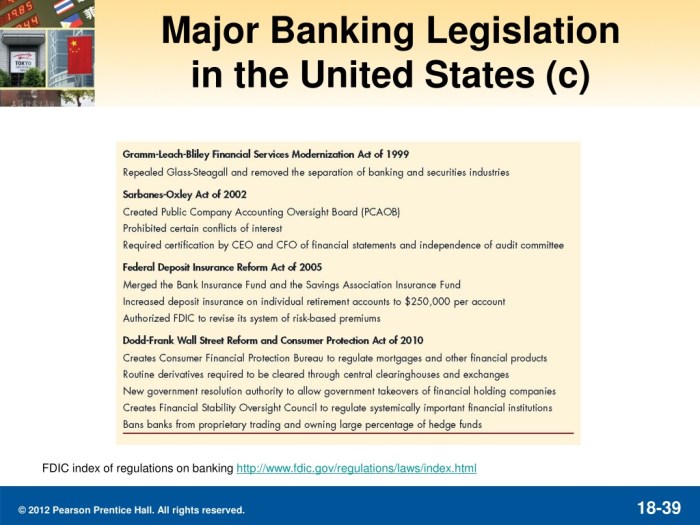Financial regulations in the U.S. takes center stage, inviting readers into a world of financial know-how with a cool vibe. Get ready for a deep dive into the rules that keep the American money scene in check.
From the purpose of regulations to their impact on innovation, this topic covers all the key aspects you need to know about financial regulations in the U.S.
Overview of Financial Regulations in the U.S.
Financial regulations in the U.S. are rules and laws put in place to oversee and control financial activities to ensure stability and protect consumers.
Purpose of Financial Regulations
Financial regulations serve to prevent fraud, manipulation, and abuse in the financial system, maintain market integrity, and protect investors and consumers.
Key Regulatory Bodies
- The Securities and Exchange Commission (SEC): Regulates securities markets and protects investors.
- The Federal Reserve: Oversees the nation’s monetary policy and supervises banking institutions.
- The Commodity Futures Trading Commission (CFTC): Regulates futures and options markets.
- The Financial Industry Regulatory Authority (FINRA): Regulates brokerage firms and exchange markets.
Historical Evolution of Financial Regulations in the U.S.
Financial regulations in the U.S. have evolved over time in response to financial crises and changing market conditions. The Securities Act of 1933 and the Securities Exchange Act of 1934 were among the first major pieces of legislation passed to regulate securities markets after the Great Depression. Subsequent laws like the Dodd-Frank Wall Street Reform and Consumer Protection Act of 2010 further expanded regulatory oversight in response to the 2008 financial crisis.
Types of Financial Regulations
Financial regulations in the U.S. can be broadly categorized into prudential regulations and market conduct regulations. Prudential regulations focus on ensuring the safety and soundness of financial institutions, while market conduct regulations aim to protect consumers and promote market integrity.
Prudential Regulations
Prudential regulations are designed to minimize the risk of financial institutions failing and causing systemic disruptions. Examples of prudential regulations in the U.S. include:
- The Dodd-Frank Wall Street Reform and Consumer Protection Act, which introduced new regulatory requirements for banks to improve their capital and liquidity positions.
- The Federal Reserve’s stress testing regime, which assesses the resilience of large banks to economic shocks.
Market Conduct Regulations
Market conduct regulations are geared towards preventing fraudulent activities, ensuring fair competition, and protecting investors. Specific regulations governing different sectors include:
- The Securities Exchange Act of 1934, which regulates securities exchanges and requires transparency in financial markets.
- The Bank Secrecy Act, which mandates banks to report suspicious activities to combat money laundering.
- The Insurance Information and Privacy Protection Act, which safeguards the privacy of insurance consumers’ information.
Role of International Regulatory Standards
International regulatory standards, such as those set by the Basel Committee on Banking Supervision and the International Organization of Securities Commissions, play a significant role in shaping U.S. financial regulations. These standards help promote consistency and cooperation among countries, especially in the context of global financial markets.
Compliance and Enforcement of Financial Regulations: Financial Regulations In The U.S.
In the world of finance, compliance with regulations is crucial to maintain stability and protect consumers. Financial institutions play a key role in ensuring that they follow the rules set by regulatory agencies to prevent fraud and misconduct.
Ensuring Compliance
- Implementing robust internal policies and procedures to adhere to regulations.
- Providing regular training to employees to keep them informed about compliance requirements.
- Conducting regular audits and assessments to identify and address any compliance gaps.
Penalties for Non-Compliance, Financial regulations in the U.S.
-
Financial penalties
can be imposed on institutions that fail to comply with regulations.
- Loss of reputation and trust in the market can have long-term consequences.
- In extreme cases,
criminal charges
may be brought against individuals or organizations.
Role of Regulatory Agencies
- Enforcing compliance by conducting regular inspections and investigations.
- Issuing guidelines and directives to clarify regulatory requirements.
- Imposing sanctions and penalties on non-compliant entities to deter future violations.
Impact of Financial Regulations

Financial regulations play a crucial role in shaping the stability and risk management within the financial sector. These regulations are put in place to protect consumers, ensure market transparency, and foster innovation. Let’s delve deeper into how financial regulations impact various aspects of the financial industry.
Effects on Financial Stability and Risk Management
Financial regulations are designed to mitigate risks and prevent financial institutions from engaging in practices that could lead to economic instability. By imposing capital requirements, liquidity standards, and stress testing, regulators aim to maintain a stable financial system that can withstand economic shocks.
Influence on Consumer Protection and Market Transparency
Regulations such as the Truth in Lending Act and the Dodd-Frank Wall Street Reform and Consumer Protection Act are put in place to safeguard consumers from predatory lending practices, ensure fair treatment, and promote market transparency. These regulations enhance trust in the financial system and protect consumers from potential exploitation.
Relationship with Innovation in the Financial Sector
While regulations are often seen as restrictive, they also play a role in fostering innovation within the financial sector. By setting clear guidelines and standards, regulations encourage financial institutions to develop new products and services that are compliant with regulatory requirements. This dynamic relationship between regulations and innovation drives advancements in technology, risk management, and financial inclusion.
